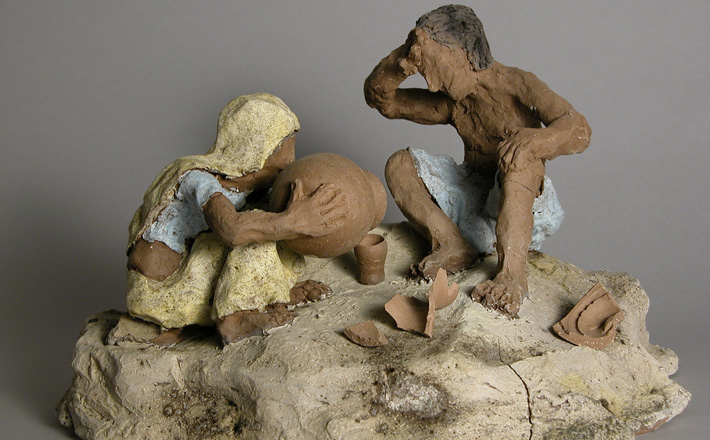Commentary on John 4:5-42
The lection assigned for the Third Sunday in Lent provides something of a study in contrasts with John 3:1-17.
If you suspect that these contrasts convey a unifying theme in the gospel of John, you would be right.
According to Lamar Williamson Jr., the Nicodemus story provides the backdrop for the happenings in chapters 4:1 through 12:50. These stories, according to Williamson, are designed to reach different kinds of readers who will, in turn, come to believe in Jesus as the Christ, the lamb who removes the sin of the world.1
Of course, the gospel is in the details and this text is no exception, especially with regard to the contrasts between the Nicodemus story and the story of the Samaritan woman at Jacob’s well. Among those contrasts: Nicodemus comes as a person in authority, as a man and a Pharisee. He plays the role of an insider, a person accustomed to being included in the loop, and one who represents a community’s best judgment.
By comparison, the woman comes to Jesus without even a name. Instead, her identity is obscured by markers of her exclusion. As a Samaritan woman, she lives her daily life in the shadows of her own marginality. She may live in the shadows of her marginality, but she speaks to Jesus under the sweltering heat of a midday sun.
Unlike Nicodemus, who “sneaks” through the streets of Jerusalem under cover of night, Jesus initiates this dialogue in broad daylight, raising eyebrows almost immediately: “How is it that you, a Jew, asks a drink of me, a woman of Samaria?” (verse 9a) and then later among the disciples who evidently found such a conversation potentially scandalous (verse 27).
Moreover, unlike Nicodemus, her condition in life seems depressingly routine: a job going nowhere, her relationships almost like her work. One relationship dissolves into the next, without much to show for it, rather like her work. Every day she goes to a well, beloved in some ways, but in other ways a painful reminder that her lot belongs in the exclusionary shadows of gender, ethnicity, and condition.
However, consistent with the emphasis of John’s testimony that light that has come into the world, this reality of darkness is again disturbed by Jesus. On the one hand, Jesus disturbs her resignation, her cynicism, which might register in her reaction to Jesus’ gentle rebuke: “If you knew the gift of God and who it is that is saying to you, ‘Give me a drink,’ you would have asked him and he would have given you living water” (verse 10).
Her reaction is both literalistic, as was Nicodemus’ and, perhaps, wearily sardonic: “Sir, give me this water, so that I may never be thirsty or have to keep coming here to draw water” (verse 15). She doesn’t hear Jesus, not really, until he says to her, “Go, call your husband, and come back” (verse 16).
“The woman answered him, ‘I have no husband.’”
One can almost hear the thud of her response. Quiet. Defeated. Maybe ashamed. Now she looks at Jesus, studies him, listens to him. Almost believes him.
Jesus said, “You are right in saying, ‘I have no husband’; for you have had five husbands, and the one you have now is not your husband.” Why does Jesus go to this issue and not some other? Is her sexuality the issue, a sense that she engages in serial relationships?
As I’ve heard this text interpreted in the past, her “problem” is the fact that she engages in serial relationships. But I sense this text is really about security and dignity. I hear a sense of crushing disappointment in life, in the drudge work assigned to her, of going to a well of promise (men who said they would take care of her) only to find that the well of covenantal manhood had run dry.
After all, Jesus does not say “Go and sin no more!” as he does to the woman accused of adultery (8:1-11). Instead Jesus speaks to her of worship in spirit and truth; not worship confined to an exclusionary zone based on gender, or ethnicity, or even geography and conventional morality, but worship including her: “God is Spirit, and those who worship him must worship in spirit and truth” (4:24).
Perhaps the way of life for women on the streets is instructive. Many women who live on the streets have “husbands” — men to whom they “marry” themselves, providing sex in exchange for food and shelter. Popular culture romanticizes marriage, but on the streets being in a partnership often functions as a form of security for women who are acutely vulnerable to predators. These exchanges may offer a measure of security, but only a measure: these marriages often come with beatings.
Walking the streets of Kansas City with a group of Catholic Workers, we visited with a woman and her “husband” waiting at the bus stop. Her eye was blackened. Her husband was going to court for domestic abuse. One of the Catholic Workers said he remembered the day the beating occurred: “She came to us the morning it happened. She woke up with him choking her,” he said.
Now she joined her “husband” at the bus stop, supporting him as he went to court to face charges of domestic battery. “Marital bliss,” sighed one of the workers. Too often they saw this same story repeated: different faces, all-too-familiar bruises.
How many husbands did she have and was the husband she had now her husband? How many times had she gone to that well of so-called security only to find that the security she hoped for was flimsy and perhaps illusory?
Symbols are significant in this text. Jacob’s well and the assurance of God’s care for all God’s people; a well that doesn’t run dry. And yet, alongside that earthly well, we witness the curious inclusion of Jesus’ thirst, repeated again at 19:28b: “I am thirsty.” In the latter text, he was given no water, but sour wine.
Likewise in this text, Jesus receives no water. It appears as if the woman has forgotten all about Jesus’ thirst, and she even leaves her water jug behind (4:28). Afterwards, this woman who seemed world-wise and -weary, speaks in unapologetic outbursts: “Come and see! Could this one be the Messiah?”
Instead of laboring in the shadows of scut work, she becomes a forerunner of the proclamation of the gospel: “Many Samaritans from that city believed in him because of the woman’s testimony, ‘He told me everything I have ever done’” (verse 39).
According to John’s gospel, a Samaritan woman joins John the Baptist, each them pointing to the One who is truly the Savior of the world.
Yet still, she has no name; she, the beloved disciple. One wonders if this story is quite complete…
Notes:
1 Lamar Williamson Jr., Preaching the Gospel of John: Proclaiming the Living Word (Louisville: Westminster John Knox Press, 2004), 46.


March 23, 2014